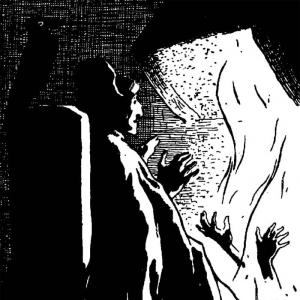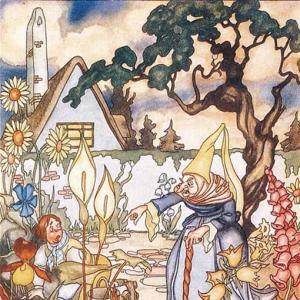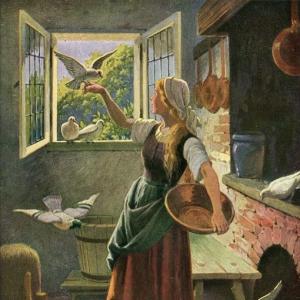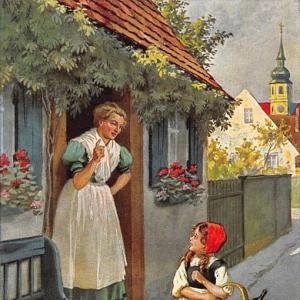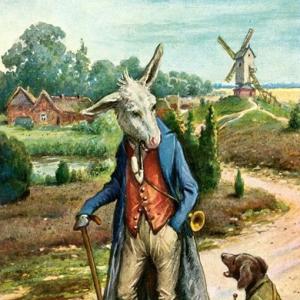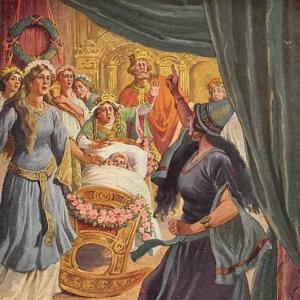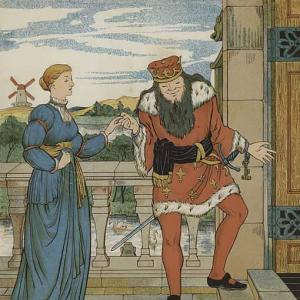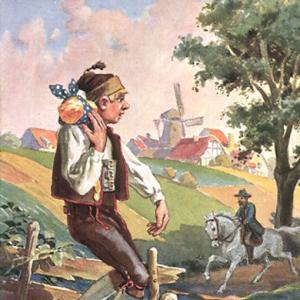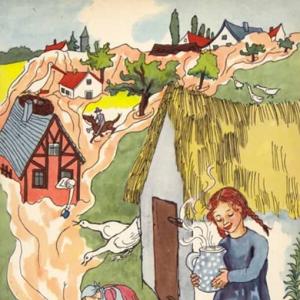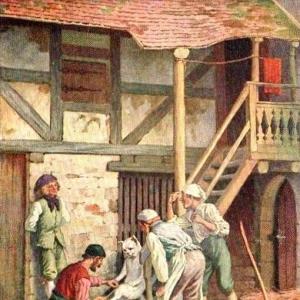Reading time for children: 3 min
A merchant had done good business at the fair. He had sold his wares, and lined his money-bags with gold and silver. Then he wanted to travel homewards, and be in his own house before nightfall.
So he packed his trunk with the money on his horse, and rode away. At noon he rested in a town, and when he wanted to go farther the stable-boy brought out his horse and said, „A nail is wanting, sir, in the shoe of its left hind foot.“ – „Let it be wanting,“ answered the merchant; „the shoe will certainly stay on for the six miles I have still to go. I am in a hurry.“
In the afternoon, when he once more alighted and had his horse fed, the stable-boy went into the room to him and said, „Sir, a shoe is missing from your horse’s left hind foot. Shall I take him to the blacksmith?“ – „Let it still be wanting,“ answered the man; „the horse can very well hold out for the couple of miles which remain. I am in haste.“
He rode forth, but before long the horse began to limp. It had not limped long before it began to stumble, and it had not stumbled long before it fell down and broke its leg. The merchant was forced to leave the horse where it was, and unbuckle the trunk, take it on his back, and go home on foot. And there he did not arrive until quite late at night. „And that unlucky nail,“ said he to himself, „has caused all this disaster.“ Hasten slowly.
 Learn languages. Double-tap on a word.Learn languages in context with Childstories.org and Deepl.com.
Learn languages. Double-tap on a word.Learn languages in context with Childstories.org and Deepl.com.Backgrounds
Interpretations
Adaptions
Summary
Linguistics
„The Nail“ is a lesser-known fairy tale by Brothers Grimm, who were German academics, linguists, and authors known for their collection of folk tales. Jacob and Wilhelm Grimm published the first edition of their collection, „Children’s and Household Tales“ („Kinder- und Hausmärchen“ in German), in 1812. This collection contained 86 stories, which were later expanded to over 200 in subsequent editions.
The Brothers Grimm are renowned for preserving and popularizing fairy tales that have become an integral part of Western culture. Some of their most famous stories include „Cinderella,“ „Snow White,“ „Hansel and Gretel,“ „Rapunzel,“ and „Little Red Riding Hood.“ Their work has had a significant influence on the development of the fairy tale genre, as well as on the study of folklore in general.
In „The Nail,“ the Brothers Grimm convey a moral lesson through the story of a merchant who faces the consequences of his haste and neglect of a seemingly minor issue. The tale emphasizes the importance of being cautious and paying attention to details, even when one is in a hurry. It also highlights the interconnectedness of events and the potential consequences of our decisions.
While „The Nail“ may not be as well-known as some of the other tales by the Brothers Grimm, it is a valuable story that imparts important life lessons in a simple and engaging manner.
„The Nail“ by Brothers Grimm can be interpreted in various ways. Some possible interpretations are:
The importance of attention to detail: The story illustrates how overlooking a seemingly insignificant detail can lead to disastrous consequences. The merchant’s failure to address the missing nail in his horse’s shoe ultimately caused delays and the loss of his horse. This teaches the importance of paying attention to even the smallest details, as they may have significant impacts.
The consequences of haste: The merchant’s haste to return home led him to dismiss the stable-boy’s concerns twice. His impatience caused him to make poor decisions, which resulted in a worse outcome than if he had taken the time to address the issue. This interpretation emphasizes the importance of taking one’s time and considering potential issues before moving forward.
The value of expert advice: The stable-boy, being more familiar with horses and their needs, recognized the potential problem and tried to warn the merchant. However, the merchant ignored the advice and suffered the consequences. This interpretation highlights the importance of listening to and valuing the expertise of others, especially when they have knowledge or experience that we may lack.
False economy: The merchant believed that he was saving time by not addressing the missing nail, but in reality, his decision ended up costing him more time and resources. This interpretation underscores the importance of considering the long-term consequences of our actions and decisions, rather than focusing solely on short-term gains.
The interconnectedness of events: The story demonstrates how one small oversight can set off a chain reaction of events that lead to an unfavorable outcome. This interpretation encourages reflection on the potential ripple effects of our decisions and actions, and how they can impact not just ourselves but also those around us.
„The Nail“ is a lesser-known fairy tale from the Brothers Grimm collection, but it has inspired a few adaptations over the years. Here are some notable adaptations:
„Der Nagel“ (1918) – This is a German silent film adaptation of the story, directed by Paul Leni. It is one of the earliest film adaptations of a Grimm fairy tale.
„The Grateful Dead“ (1967) – This is a psychedelic rock song by the band, The Grateful Dead, which takes its name from the folktale motif that appears in „The Nail.“ The song’s lyrics refer to the story’s theme of keeping one’s promises and being rewarded for kindness.
„The Blacksmith and the Nail“ (2013) – This is a short animated film by the Russian animator, Dmitry Geller. It is a modern retelling of the story, in which the blacksmith is a woman who runs a small business and promises to fix a customer’s bicycle.
„Der Nagel“ (2016) – This is a German stage adaptation of the story, produced by the Theater Mär in Berlin. The production uses puppetry and live music to tell the story of the blacksmith and the wandering musicians.
„The Nail“ (2020) – This is a short film by the Canadian filmmaker, Michael Enzbrunner. It is a modern retelling of the story, set in a small town in Canada. The film explores the themes of honesty, integrity, and the consequences of one’s actions.
In „The Nail“ by Brothers Grimm, a merchant has a successful day at the fair, selling his wares and filling his money-bags with gold and silver. Eager to return home before nightfall, he packs his trunk with money on his horse and sets off. During his journey, he stops at a town to rest. The stable-boy informs him of a missing nail in the horse’s left hind shoe, but the merchant dismisses the concern, citing his urgency to reach home.
Later in the afternoon, the merchant stops again to feed his horse. The stable-boy reiterates the issue with the missing shoe, but the merchant again dismisses the problem, believing the horse can make it the remaining miles without issue. However, as he continues riding, the horse begins to limp, then stumble, and finally falls, breaking its leg. The merchant has no choice but to leave the horse, carry the trunk on his back, and proceed on foot. He arrives home late at night, realizing that the overlooked nail led to his misfortune.
The moral of the story is to „hasten slowly,“ emphasizing the importance of taking care of small details and not rushing through tasks or decisions, as neglecting them can lead to greater problems.
The fairy tale „The Nail“ by the Brothers Grimm is a short narrative that serves as a cautionary tale about the consequences of neglecting seemingly small and insignificant details. A linguistic analysis of the text can provide insight into its thematic elements, structure, and style.
Narrative Structure
The story follows a straightforward linear progression typical of folktales.
It is divided into three main parts: the merchant’s initial successful venture at the fair, his encounters with the stable-boy, and the resulting downfall due to his negligence. Each section builds upon the previous one, showcasing a clear cause-and-effect relationship.
Themes and Morals
Negligence and Consequences: The repeated dismissal of the missing nail underscores the theme of negligence. The merchant’s prioritization of haste over thoroughness illustrates the moral lesson encapsulated in the phrase „Hasten slowly. “ This implies that rushing through tasks without attention to detail can lead to greater trouble.
Causality: The narrative highlights a chain reaction set off by a minor issue—a missing nail. This illustrates how a small problem can escalate into a larger one, emphasizing the importance of addressing issues no matter how trivial they seem.
Language and Style
Repetition: The story employs repetition, particularly in the dialogue between the merchant and the stable-boy. The phrase „Let it be wanting“ is repeated, reinforcing the merchant’s dismissive attitude and his prioritization of urgency over care.
Dialogue: The dialogue is brief and functional, allowing the focus to remain on the actions and consequences rather than character development. This is a common feature in fables and fairy tales where the emphasis is on the moral or lesson rather than complex character arcs.
Simplicity and Clarity: The language used is clear and straightforward, making the story accessible to a broad audience. The simplicity helps convey the moral without ambiguity, a typical characteristic of the Brothers Grimm’s fairy tales, which often aim to impart a clear ethical lesson.
Symbolism: The nail, though small and easily overlooked, symbolizes the importance of attention to detail. It represents how minor components can be integral to the functionality of a whole system, echoing the concept that „for want of a nail, the kingdom was lost. “
Conclusion
„The Nail“ is a didactic narrative that uses linguistic simplicity, repetition, and a clear cause-and-effect structure to convey its moral lesson. The tale warns against the dangers of neglect and the potential for small oversights to lead to significant repercussions. Through its language and structure, the story reinforces the timeless advice to „hasten slowly,“ advocating for careful consideration and thoroughness in actions.
Information for scientific analysis
Fairy tale statistics | Value |
|---|---|
| Number | KHM 184 |
| Aarne-Thompson-Uther-Index | ATU Typ 2039 |
| Translations | DE, EN, DA, ES, FR, PT, IT, JA, NL, PL, RU, TR, VI, ZH |
| Readability Index by Björnsson | 24.7 |
| Flesch-Reading-Ease Index | 88.2 |
| Flesch–Kincaid Grade-Level | 4.9 |
| Gunning Fog Index | 7.4 |
| Coleman–Liau Index | 6.9 |
| SMOG Index | 6.9 |
| Automated Readability Index | 4.6 |
| Character Count | 1.374 |
| Letter Count | 1.033 |
| Sentence Count | 17 |
| Word Count | 268 |
| Average Words per Sentence | 15,76 |
| Words with more than 6 letters | 24 |
| Percentage of long words | 9% |
| Number of Syllables | 325 |
| Average Syllables per Word | 1,21 |
| Words with three Syllables | 7 |
| Percentage Words with three Syllables | 2.6% |



